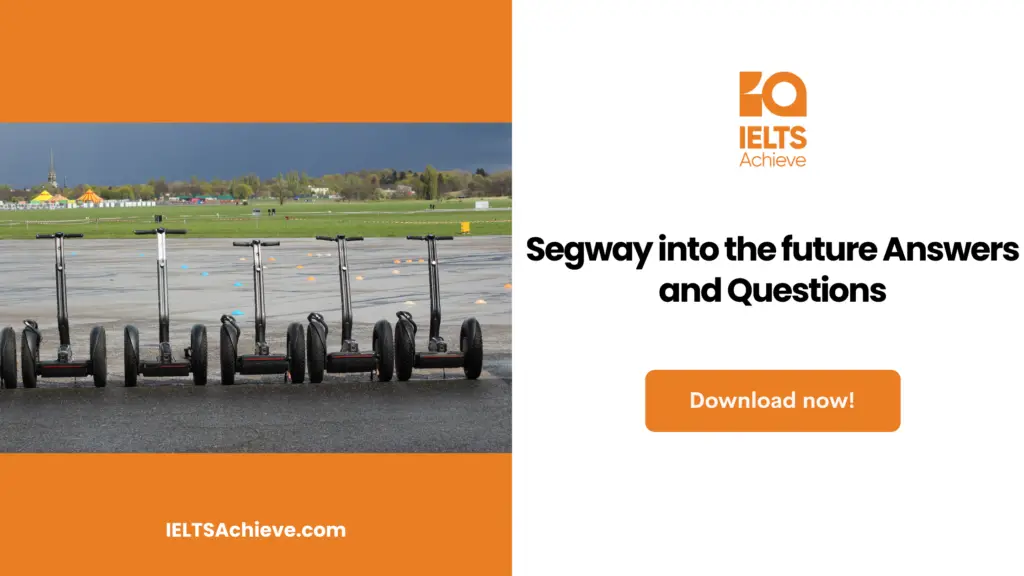The Blog post contains the following IELTS Reading Questions:
- IELTS reading True/False/Not Given
- IELTS reading Multiple Choice questions
- IELTS reading Sentence Completion
Stay informed and prepared for success – Explore our comprehensive Reading Test Info page to get valuable insights, exam format details, and expert tips for mastering the IELTS Reading section.
IELTS Reading Passage: Segway into the future

Segway into the Future
Will the electric vehicle known as the Segway alter the ways that individuals get around? Dean Kamer, the inventor of the Segway, believes that this revolutionary vehicle will someday substitute for the bicycles and automobiles that now crowd our cities. When he introduced the Segway in 2001, he believed it would change our lives.
Although the Segway uses up-to-the-minute technology, it looks very ordinary. The metal framework of the Segway consists of a platform where an individual stands. Attached to the front of the platform is a tall post with handles for the driver to hold. On each side of the platform is a wide, rubber wheel. Except for these two wheels, there are no mechanical parts on the Segway. It has no engine, no brakes, no pedal power, no gears, and no steering wheel.
Instead it uses a computer system that imitates the ability of humans to keep their balance. This system seems to move to the driver’s thoughts. For example, when the driver thinks “Go forward’’, the Segway moves forwards, and when the driver thinks, “Stop’’, it stops. The Segway is not really responding to the driver’s thoughts, but to the tiny changes in balance that the driver makes as he prepares his body to move forward or to stop. For example, when the driver thinks about moving forward, he actually leans slightly forward, and when he thinks of stopping or slowing, the driver leans slightly back.
The Segway is powered by batteries that allow it to travel about T7 Miles on one battery charge. It is designed for short-range, low-speed operation. It has three speed settings. The slowest is the setting for learning, with speeds of up to 6 miles per hour. Next is the sidewalk setting, with speeds of up to 9 miles per hour. The highest setting allows the driver to travel up to 12.5 miles per hour in open, flat areas. At all three speed settings, the Segway can go wherever a person can walk, both indoors and outdoors.
Workers who must walk a lot in their jobs might be the primary users of Segways. For example, police officers could drive Segways to patrol city streets, and mail carriers could drive from house to house to deliver letters and packages. Farmers could quickly inspect distant fields and bams, and rangers, or parks. Security guards could protect neighbourhoods or large buildings.
Any task requiring a lot of walking could be made easier. In cities, shoppers could leave their cars at home and ride Segway from store to store. Also, people who cannot comfortably walk due to age, illness, or injury could minimise their walking but still be able to go many places on a Segway.
Why is it, then, that our job sites, parks, and shopping centres have not been subsequently filled with Segways since they were introduced in 2001? Why hasn’t the expected revolution taken place? Studies have shown that Segways can help workers get more done in a shorter time. This saves money. Engineers admire Segways as a technological marvel.
Business, government agencies, and individuals, however, have been unwilling to accept the Segway. Yes, there have been some successes. In a few cities, for example, mail carriers drive Segway on their routes, and police officers patrol on Segways. San Francisco,
California, and Florence, Italy, are among several cities in the world that offer tours on Segways for a small fee. Occasionally you will see golfers riding Segways around golf courses. Throughout the world more than 150 security agencies use Segways, and China has recently entered the overseas market. These examples are encouraging, but can hardly be called a revolution.
The primary reason seems to be that people have an inherent fear of doing something new. They fear others will laugh at them for buying a “toy’’. They fear losing control of the vehicle. They fear being injured. They fear not knowing the rules for using a Segway. They fear making people angry if they ride on the sidewalk. All these fears and others have kept sales low.
The inventor explained why people have been slow to accept the Segway. He said, “We didn’t realise that although technology moves very quickly, people’s mind-set changes very slowly.” Perhaps a hundred years from now millions of people around the world will be riding Segways.
Unlock your full potential in the IELTS Reading section – Visit our IELTS Reading Practice Question Answer page now!
Recommended Questions:
Renewable Energy IELTS Reading Question with Answer
Questions
Questions 1-3
Do the following statements agree with the information given in Reading Passage 2?
- TRUE if the statement agrees with the information
- FALSE if the statement contradicts the information
- NOT GIVEN if there is no information on this
1. The Segway’s framework consists of a platform and a post with handles
2. The driver can alter the direction of the Segway by leaning to the left or right
3. The Segway was primarily designed for student to make their travel much more comfortable
Unlock your full potential in the IELTS Reading section – Visit our IELTS Reading Practice Question Answer page now!
Recommended Questions:
Renewable Energy IELTS Reading Question with Answer
Questions 4-6
Choose the correct letter, A, B, C or D.
4. Why has the Segway been accepted as the most comfortable vehicle for the people with moving problems?
A. they could leave their cars at home and ride Segway from store to store
B. could drive from house to house to deliver letters and packages
C. could quickly inspect distant fields and barns, and rangers, or parks
D. could minimise their walking.
5. Why have people been slow to accept the Segway?
A. it wastes too much money
B. people have the various hinds of fears
C. it was too hard to manage
D. people didn’t want to replace the existing vehicles
6. According to the point of view of the Dean Kamen, although technology moves very quickly, people’s mindset changes very slowly. What did he mean by this?
A. people cannot accept the innovation at once
B. because of people worldwide ride bicycles for transportation they cannot accept other hinds of vehicles
C. people have fears and thus cannot get accustomed with new forms of transportation
D. the ideas and attitudes with which a person approaches a situation cannot be quickly altered
Ready to improve your performance in Multiple Choice Questions (MCQs)? Click here to access our comprehensive guide on how to tackle MCQs effectively in the IELTS Reading section.
Questions 7-14
Complete the sentences. Choose NO MORE THREE WORDS from the passage for each answer.
Dean Kamer, the inventor of the Segway, believes that this revolutionary vehicle will replace all conveyances we use today, and in 2001 he presented his innovation to the public. Even though the Segway uses up the minimum energy, it has a very 7.______ appearance. It has not engine, brakes, gears and even 8.______ , however, the attribute is that it has the 9.______ with wide and rubber wheels. Moreover, this invention is designed for short-term destinations and works with 10.______ . As it minimises the moving time or energy, the Segway, particularly fits those people who has an active lifestyle such as 11.______ , mail carriers; farmers, security guards and even those who have difficulties because of their 12.______ . However, the inventor explains why people have difficulties in accepting the Segway. He believes that the main reason for this is that people have an innate 13.______ of doing innovations and because of that the people’s 14._______ always changes gradually, it is too hard to accept the new invention for a short time.
Enhance your sentence completion skills in the IELTS Reading section. Click here to access our comprehensive guide and learn effective strategies for filling in missing words or phrases in sentences.
Unlock your full potential in the IELTS Reading section – Visit our IELTS Reading Practice Question Answer page now!
Recommended Questions:
Renewable Energy IELTS Reading Question with Answer
Answers for Segway into the future
Solution for 1: True
Solution for 2: Not Given
Solution for 3: Not Given
Solution for 4: D
Solution for 5: B
Solution for 6: D
Solution for 7: Ordinary
Solution for 8: steering wheel
Solution for 9: Platform
Solution for 10: Batteries
Solution for 11: Police Officers
Solution for 12: Age, Injury
Solution for 13: Fear
Solution for 14: Mindset

We hope you found this post useful in helping you to study for the IELTS Test. If you have any questions please let us know in the comments below or on the Facebook page.
The best way to keep up to date with posts like this is to like us on Facebook, then follow us on Instagram and Pinterest. If you need help preparing for the IELTS Test, join the IELTS Achieve Academy and see how we can assist you to achieve your desired band score. We offer an essay correction service, mock exams and online courses.

